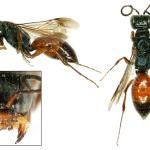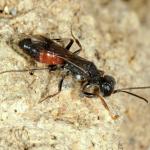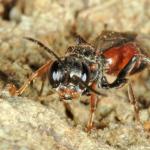A scarce southern species that resembles a red and black ichneumon wasp. Packer (1987) lists records and observations to the early 1980s (as Alysson lunicornis).
Southern England from the Devon side of Lyme Regis to east Kent and north to Huntingdonshire and Warwickshire. A record from Norwich (Bridgman, 1875) remains unconfirmed. Abroad, widespread but uncommon in Europe (excluding Fennoscandia); also north Africa and Mongolia.
Listed in Shirt (1987) as Rare (RDB3) and as Notable A (now known as Scarce (Na)) by Falk (1991). Until fairly recently, this species was regarded as a rarity, with most of its records coming from the 19th century. It is unclear whether the flush of records over the past two decades indicates an increase in its status and range or whether it had been overlooked as an ichneumon or pompilid. Packer, Dicker and Falk have all managed to locate clusters of nesting aggregations by carefully examining likely sites.
Strongly associated with the deep desiccation cracks that appear on clay or clay-rich ground during summer months. Many records relate to coastal soft rock cliffs, whilst inland records include unimproved grasslands (especially south-facing slopes), woodland rides and clearings, and re-vegetating quarries.
Univoltine; a late summer species, appearing in July and persisting until October. Males appear before females.
Cells are provisioned with homopteran bugs, usually leaf- and plant-hoppers of the families Cicadellidae and Delphacidae (Lomholdt, 1975-76; Richards, 1980). Females seem to hunt mainly in tall grass and other coarse herbage, and are usually less evident around nesting areas than the males.
In Britain, nesting occurs in loose aggregations, specifically in the deep desiccation cracks that appear in clayey soils. Such nesting areas often coincide with spring mining-bee colonies, and usually occur in sparsely-vegetated or well-cropped areas fully exposed to the sun. The nest consists of a rather long tunnel terminating in a single cell. Males fly very rapidly over nesting areas in loose 'swarms' (rather like the males of many Andrena species) and searching for such 'swarms' over desiccation cracks is one of the easiest ways of locating populations.
Males visit the flowers of umbellifers such as wild carrot and wild parsnip. It is unclear whether females visit flowers.
No information available.
2001




